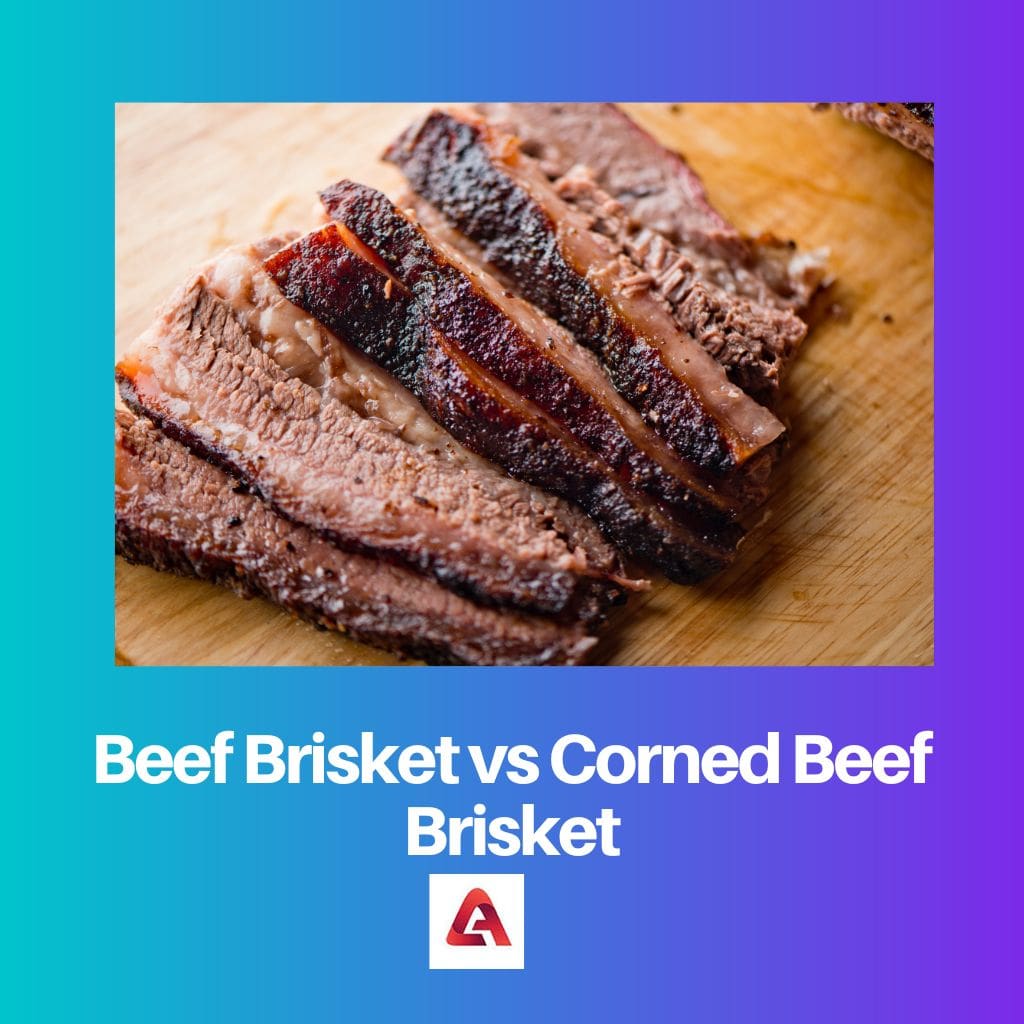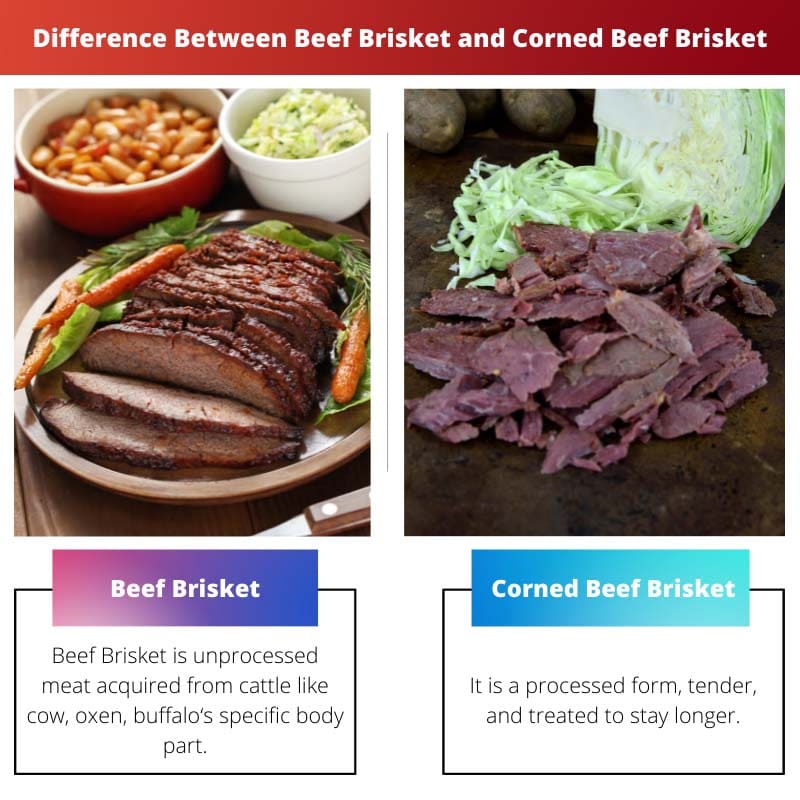Beef brisket is a classic cut of beef known for its rich flavor and tenderness, slow-cooked to perfection. Corned beef brisket, on the other hand, undergoes a curing process with brine and spices, resulting in a savory, slightly salty taste, commonly associated with dishes like corned beef and cabbage.
Key Takeaways
- Beef Brisket is an unprocessed cut of beef taken from the lower chest, while Corned Beef Brisket is beef brisket cured in brine.
- Beef Brisket has a beefy flavor and tender texture, while Corned Beef Brisket has a salty and tangy taste with a firm texture.
- Beef Brisket is smoked or slow-cooked, while Corned Beef Brisket is boiled and served with vegetables.
Beef Brisket vs. Corned Beef Brisket
Beef brisket means a piece of chest meat or lower chest area of a cow. It is slow cooked and is soft and juicy with rich flavors. Corn-beef brisket is a beef meat with extra preserved seasoning of salt, spices and herbs, rich with flavors, resembles Irish dishes.

Comparison Table
| Feature | Beef Brisket | Corned Beef Brisket |
|---|---|---|
| Origin | Raw, uncut brisket | Cured brisket (originally with large “corns” of salt) |
| Cut | Can be flat cut (lean) or point cut (fattier) | Typically comes from the flat cut for better shape retention during brining |
| Preparation | Requires seasoning and lengthy cooking (smoking, braising) | Pre-seasoned and requires shorter cooking time (boiling, simmering) |
| Flavor | Rich beefy flavor, varies based on seasoning and cooking method | Salty, savory, with pickling spice notes |
| Texture | Tough initially, becomes tender and juicy when cooked properly | Tender and slightly chewy due to brining process |
| Uses | Pulled beef, sliced BBQ, pastrami (after additional seasoning and smoking) | Sandwiches, Reuben sandwiches, hash, stews |
| Availability | Found in the butcher shop, whole or pre-cut | Found in the butcher shop or pre-packaged in the deli section |
What is Beef Brisket?
Beef brisket is a primal cut of meat derived from the breast section of the cow, situated beneath the first five ribs. This cut is renowned for its rich flavor and versatility in various culinary preparations.
Anatomy and Characteristics
Beef brisket is composed of two distinct muscles: the flat and the point. The flat, also known as the “first cut” or “lean cut,” is a long, lean muscle with minimal fat content, making it ideal for slicing. In contrast, the point, referred to as the “second cut” or “deckle,” contains more intramuscular fat, rendering it juicier and more flavorful when cooked.
Culinary Uses
- Slow Cooking: Beef brisket is frequently slow-cooked or braised to achieve optimal tenderness. The tough connective tissue breaks down during the cooking process, resulting in a succulent, melt-in-your-mouth texture.
- Smoking: Brisket is a quintessential cut for smoking, popular in barbecue culture. The low-and-slow smoking method infuses the meat with a smoky flavor while rendering it tender and moist.
- Roasting: Roasting beef brisket in the oven is another method to attain tender, flavorful results. Slow roasting at a low temperature allows the meat to cook evenly and develop a rich caramelized crust.
Culinary Preparations
- Seasoning: Beef brisket readily absorbs seasonings and marinades, enhancing its natural flavors. Common seasonings include salt, pepper, garlic, onion powder, paprika, and various herbs and spices.
- Brisket Rubs: Rubs consisting of a blend of spices and herbs are applied to the surface of the brisket before cooking, adding depth and complexity to the flavor profile.
- Barbecue Sauces: While brisket is flavorful on its own, barbecue sauces can be applied during or after cooking to add a sweet, tangy, or spicy element to the dish, complementing the beef’s richness.

What is Corned Beef Brisket?
Corned beef brisket is a flavorful variation of beef brisket that undergoes a unique curing process with brine and spices, resulting in a distinct taste profile.
Curing Process and Ingredients
- Brining: Corned beef brisket is cured in a brine solution consisting of water, salt, sugar, and pickling spices. The brisket is submerged in the brine for several days to weeks, allowing the flavors to penetrate the meat and impart a characteristic tanginess.
- Pickling Spices: The brine contains a blend of aromatic spices such as whole peppercorns, mustard seeds, coriander seeds, bay leaves, and cloves. These spices contribute to the unique flavor profile of corned beef, infusing it with layers of complexity and depth.
Flavor Profile and Texture
- Savory and Salty: The curing process imparts a savory, slightly salty taste to corned beef brisket, distinguishing it from its uncured counterpart. The saltiness enhances the natural flavor of the beef, creating a bold and appetizing dish.
- Tender and Juicy: Despite its initial toughness, corned beef brisket becomes tender and succulent after the curing process and subsequent cooking methods. Slow cooking, such as simmering or braising, allows the meat to become fork-tender while retaining its juiciness.
Culinary Uses and Traditions
- St. Patrick’s Day Staple: Corned beef brisket is closely associated with St. Patrick’s Day celebrations, particularly in Irish-American cuisine. It is traditionally served alongside cabbage, potatoes, and other root vegetables in a hearty and satisfying meal.
- Sandwiches and Reubens: Thinly sliced corned beef brisket is a popular choice for sandwiches, particularly the classic Reuben sandwich. Layered with Swiss cheese, sauerkraut, and Russian dressing, it offers a delicious blend of flavors and textures.
- Hash and Breakfast Dishes: Leftover corned beef brisket finds its way into breakfast dishes such as hash, omelets, or breakfast burritos, adding a savory element to the morning meal.
Cooking Methods and Tips
- Slow Simmering: Corned beef brisket is cooked by simmering in liquid, such as water or broth, for an extended period. This method allows the meat to become tender while infusing it with the flavors of the cooking liquid and spices.
- Additional Flavorings: While the brisket is cooking, additional ingredients such as onions, garlic, carrots, and celery can be added to the pot to enhance the overall flavor profile of the dish.

Main Differences between Beef Brisket Corned Beef Brisket
- Preparation:
- Beef Brisket: Seasoned and cooked through methods like slow cooking, smoking, or roasting.
- Corned Beef Brisket: Cured in a seasoned brine solution before cooking, boiled or simmered.
- Flavor Profile:
- Beef Brisket: Rich, beefy flavor with potential seasoning and smoky notes.
- Corned Beef Brisket: Savory and slightly salty taste due to the curing process, with hints of pickling spices.
- Texture:
- Beef Brisket: Tender and succulent, depending on cooking method and cut.
- Corned Beef Brisket: Tender and juicy, sliced thinly for sandwiches or served in chunks.
- Culinary Uses:
- Beef Brisket: Versatile for barbecue, roasts, stews, sandwiches, and more.
- Corned Beef Brisket: Traditionally associated with St. Patrick’s Day, commonly used in sandwiches, hashes, and breakfast dishes.
- Cooking Methods:
- Beef Brisket: Slow-cooked through methods like braising, smoking, or roasting to achieve tenderness.
- Corned Beef Brisket: Boiled or simmered in liquid to cook the cured meat until tender.



